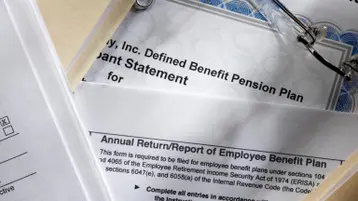The Impact of Employee Benefits on Recruitment and Retention

Table of contents
- 1.Challenges in Attracting Top Talent
- 2.Why is Employee Retention So Important?
- 3.Advantages of Offering Benefits
- 4.How A Strong Benefits Program Can Help Attract and Retain Employees
- 5.Heightened Employee Satisfaction and Employee Engagement
- 6.Reduced Employee Turnover
- 7.Stronger Company Brand
- 8.Enhanced Recruitment Process
- 9.How to Build a Good Employee Benefits Program
- 10.Keep Traditional Benefits
- 11.Choose Fringe Benefits Carefully
- 12.Add in Mental Health Benefits
- 13.Offer Avenues for Employee Career Growth
- 14.Support a Healthy Work-Life Balance
- 15.Consider Flexible Work Arrangements
Ever since the pandemic, inflation and salary increases have moved differently. In 2022, the average salary increase was 3.4%, while the inflation rate was 7.9%.1 Although the gap is starting to close as inflation seems to be slowing down and salaries appear to continue to increase, many employees are focusing more on benefits and it’s becoming an increasingly important part of their compensation package. The importance of employee benefits in recruitment and retaining top talent for small to medium-sized businesses (SMBs) is, therefore, something to pay attention to. Here, we'll provide a deeper look at the impact of improving employee benefits packages for SMBs.
Challenges in Attracting Top Talent
SMBs tend to face unique challenges when it comes to their recruitment strategy. For one, they generally have fewer resources than big organizations or Fortune 500 companies. This can make it difficult to spend the time and money on hiring. With smaller budgets, offering competitive salaries or additional benefits may also be more difficult. Other challenges may include:
- Less brand recognition than larger corporations
- Fewer opportunities for growth or professional development
- Lack of marketing visibility among larger organizations
- Competition from larger organizations
- Potentially perceived instability of new companies
- Geographic limitations if SMBs aren't in big cities
- Limited brand recognition for employee resumes in the future
Although most of the challenges revolve around resources, using benefits can help. It's a great way to attract top talent and show them that you're committed to your team's health and wellness in various ways.
Why is Employee Retention So Important?
The average annual turnover rate in the US is 47%.2 Although this turnover includes both voluntary and involuntary leave, it still equates to almost one out of every two employees leaving the business by the end of the year. Every year, this costs US businesses $1 trillion... yet it can be prevented.3
The average cost of replacing one employee tends to range from about one-half to two times their annual salary.4 The true cost will depend on their role and level of expertise, but it's not cheap. Low retention rates can also dampen productivity and have an impact on employee morale throughout your SMB. High retention rates, in turn, can help boost employee productivity and result in high employee experience and engagement.
Advantages of Offering Benefits
In addition to being a good part of your retention strategy, there are several advantages of offering benefits and perks. Some of the most notable include:
- Help retain employees in a competitive market
- Attract high-quality candidates for open positions
- Improve employee satisfaction and overall morale
- Heightened employee loyalty
- Create a positive work environment
- Increase productivity and employee engagement
- Better health and wellness outcomes that can result in fewer sick days
- Strengthened employee brand and reputation
- Benefits compliance and risk mitigation
- Lower operating costs due to effects of benefit offerings
- Tax incentives for certain contributions, such as health insurance and retirement benefits
How A Strong Benefits Program Can Help Attract and Retain Employees
Over the past few years, many businesses have experienced volatile changes in their workforce. The Great Resignation showed many business owners that their workforce would no longer stay in a position they weren't appreciated in, weren't compensated appropriately for and weren't given new benefits to offset the changes in the world around them. Unfortunately, it might be difficult for SMBs to increase salaries for every employee. Fortunately, pay and benefits are both a part of compensation plans that can help attract and retain top talent.
Heightened Employee Satisfaction and Employee Engagement
Employers that offer competitive benefits tend to experience higher overall workforce satisfaction within their respective roles. This can result in more productivity, stronger loyalty, better company culture and more. The more satisfied someone is within their position, the more engaged they tend to be. Employees who feel like they're being taken care of are more likely to commit to the organization and focus on achieving their goals, which is good for overall business success.
Reduced Employee Turnover
43% of employees have said their current benefits packages have kept them in their current role.5 That's because someone is more likely to stay at an organization that takes care of them and shows a commitment to their overall happiness. If you want to improve retention, it's essential to factor in the benefits package during the recruitment and onboarding process.
Stronger Company Brand
A good benefits program can also improve your company's brand, as it sets you apart from the competition. Satisfied employees who benefit from company perks become brand advocates, positively influencing public perception and attracting diverse talent. This can create a stronger recruitment process in the future and have cascading effects on your growing workforce.
Enhanced Recruitment Process
In terms of recruitment, creating a package of benefits to offer and showing candidates either within the job posting or at the interview can make a big difference. Although you may need to increase your budget to accommodate certain benefits, you'll likely decrease the amount you spend on recruitment and save money with improved retention. Even if it doesn't seem like it, benefits can impact your pool of job applicants.
How to Build a Good Employee Benefits Program
Understanding industry-leading benefits is the first step in enhancing the employee experience. While you might not be able to provide every single benefit, narrowing down your options to strategic perks and benefits is a good starting point. Here are a few ways employers can use a competitive benefits package to help improve employee retention and appeal to top talent.
Keep Traditional Benefits
Traditional benefits include health insurance, retirement benefits, disability insurance, life insurance and more. These should be kept in place, if possible, as they're generally the standard across all industries. Many businesses are also adding more family and reproductive health benefits to help employees with their personal lives. Doing so can help employees with more opportunities to grow their families, which shows them your support for their wellness outside of the office.
Choose Fringe Benefits Carefully
Many non-traditional offerings are the benefits employees want to help support their overall health and well-being. For example, a company that offers flexible work arrangements may be more attractive to someone than a company that requires 40 hours on-site with no exceptions. The benefits you offer should be carefully chosen based such factors as your workforce's demographics, industry standards and your team's interests. If you're unsure what your team wants, try surveying to understand employee needs better.
Add in Mental Health Benefits
In addition to traditional health insurance benefits, it's important to consider your team's mental health and well-being. These benefits are becoming increasingly sought after, especially gym memberships, smoking cessation programs, dental coverage, psychological care coverage, stress management programs, access to therapists and more. The number of benefits can significantly impact long-term retention, so it's worth considering in your budget.
Offer Avenues for Employee Career Growth
Companies can also offer benefits such as tuition reimbursement programs, professional development stipends, access to online learning platforms, mentorship opportunities and career coaching services. Providing these avenues for growth demonstrates the company's investment in employees' long-term success and encourages them to pursue continuous learning and skill development. Additionally, offering clear pathways for career advancement, such as internal promotion opportunities and succession planning initiatives, can motivate employees to stay with the company and contribute to its growth.
Support a Healthy Work-Life Balance
US companies tend to offer one of the lowest number of paid time off (PTO) days in the world. There are no requirements for the number of PTO days a US employee gets, but many businesses may offer 10 to 15 days per year. The US average is low compared to European countries, which provide 30 to 35 days. Offering more PTO days may be a good idea to support your teams' work-life balance. It shouldn't impact the success of your business, but a few extra days can be a great way to increase the attractiveness of job openings for high-quality candidates.
Consider Flexible Work Arrangements
Allowing employees to work from home or to have a slightly different schedule than "traditional" business hours is also important. After the pandemic, many people got comfortable working from home and the abrupt shift has caused some disconnect. While not all industries and businesses can offer flexible work times, allowing for telecommuting, remote or hybrid options, if possible, can significantly add to your benefits package with less impact on your budget.
If you're struggling to create an effective benefits package, consider working with a professional employer organization like TriNet. TriNet offers comprehensive human capital consulting solutions to help you handle your toughest HR needs. Through expert HR guidance, risk mitigation, and simple payroll processing, you’ll enjoy access to HR experts who understand how to help overcome industry-specific HR issues while helping you support a strong employee retention rate.
This communication is for informational purposes only, is not legal, tax or accounting advice, and is not an offer to sell, buy or procure insurance.
This article may contain hyperlinks to websites operated by parties other than TriNet. Such hyperlinks are provided for reference only. TriNet does not control such web sites and is not responsible for their content. Inclusion of such hyperlinks on TriNet.com does not necessarily imply any endorsement of the material on such websites or association with their operators.

TriNet Team
Table of contents
- 1.Challenges in Attracting Top Talent
- 2.Why is Employee Retention So Important?
- 3.Advantages of Offering Benefits
- 4.How A Strong Benefits Program Can Help Attract and Retain Employees
- 5.Heightened Employee Satisfaction and Employee Engagement
- 6.Reduced Employee Turnover
- 7.Stronger Company Brand
- 8.Enhanced Recruitment Process
- 9.How to Build a Good Employee Benefits Program
- 10.Keep Traditional Benefits
- 11.Choose Fringe Benefits Carefully
- 12.Add in Mental Health Benefits
- 13.Offer Avenues for Employee Career Growth
- 14.Support a Healthy Work-Life Balance
- 15.Consider Flexible Work Arrangements






